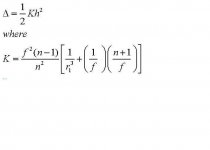The formula is general for all lenses with two sperical surfaces, you just need to know the radii of curvature for the lens, and its focal length, etc. I think that is what you are asking, but I'm not sure.
Does that assume the standard signs?
By general convention in optical design, curves that bulge out to the left are positive and curves that bulge out to the right are negative. Optical systems are drawn so the light is travelling from left to right. So:
A DCX lens has r1 > 0, and r2 < 0.
A DCV lens has r1 < 0, and r2 > 0.
A PCX lens with the flat side to the right has r1 > 0, r2 = infinite.
A meniscus lens has r1 & r2 with the same sign.
By general convention in optical design, curves that bulge out to the left are positive and curves that bulge out to the right are negative. Optical systems are drawn so the light is travelling from left to right. So:
A DCX lens has r1 > 0, and r2 < 0.
A DCV lens has r1 < 0, and r2 > 0.
A PCX lens with the flat side to the right has r1 > 0, r2 = infinite.
A meniscus lens has r1 & r2 with the same sign.
I plugged some numbers into the equation for a 50mm diameter DCX, 250mmFL, and I got a focal error of 3.44mm. I then used the same numbers but made the diameter 100mm, which gave a focal error of 13.78mm. These results seem to be with-in reason. When I tried to use the modified equation without the r2 values, the results went out the window. After re-reading your response,
DJ
I must have missed the bit where you said “two spherical surfaces”, So there must be another equation for PCX lenses (single spherical surface).The formula is general for all lenses with two sperical surfaces, you just need to know the radii of curvature for the lens, and its focal length, etc. I think that is what you are asking, but I'm not sure.
DJ
No not at all, a flat surface is an infinite radius of curvature, and 1/infinity = 0. So your equation was right. If you know the focal length of the lens you can determine the radius of curvature using:
1/f=(n-1)(1/r1)
Hope this helps.
1/f=(n-1)(1/r1)
Hope this helps.
focii of a parabola
I remember doing this in High school geometry but cant find the equation for it, what Im trying to do is find the 2 focal points to make a parabola X wide by Y tall, does anyone know the formula or where I can figure it out? I did it once as a kid making a window for a mexican restaraunt but I know there has to be a better way than trial and error till you get the size you want.
thanks
Jack
I remember doing this in High school geometry but cant find the equation for it, what Im trying to do is find the 2 focal points to make a parabola X wide by Y tall, does anyone know the formula or where I can figure it out? I did it once as a kid making a window for a mexican restaraunt but I know there has to be a better way than trial and error till you get the size you want.

thanks
Jack
- Status
- Not open for further replies.
